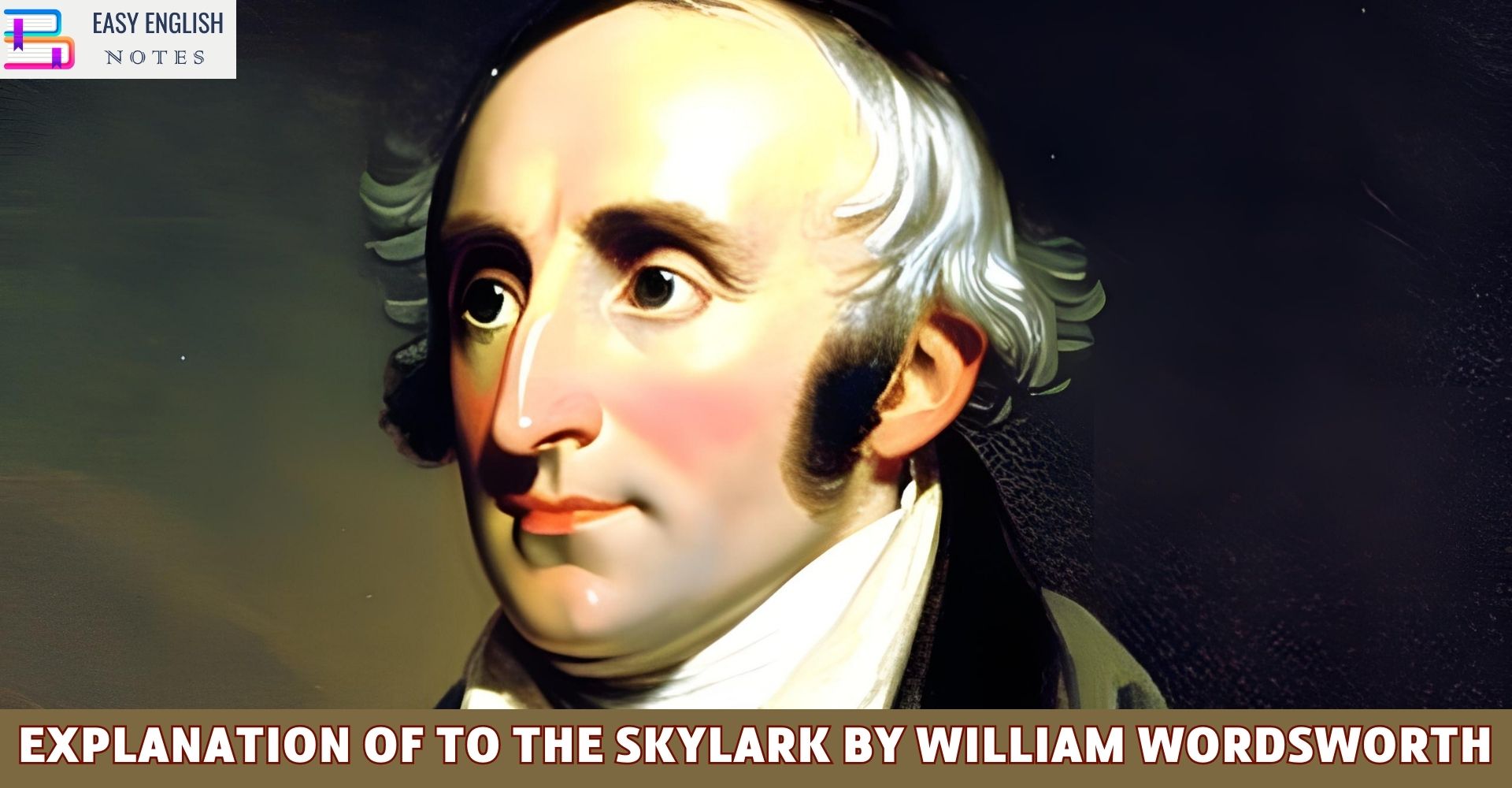Ethereal Minstrel! pilgrim of the sky!
Dost thou despise the earth where cares abound?
Or while the wings aspire, are heart and eye
Both with thy nest upon the dewy ground?
Thy nest which thou canst drop into at will,
Those quivering wings composed, that music still!
These lines have been taken from William Wordsworth’s poem entitled To The Skylark. The poet addresses the skylark as a singer of the upper air and a traveller in the sky, for the skylark sings at a great height in the sky. He refers to the lofty flight of the skylark and asks if it despises the earth which is full of cares and anxieties. He suggests that the skylark is not a scorner of the earth though it is full of cares and worries. As the skylark soars high. its heart and eyes are always fixed on its nest below and it can drop down at will on that nest by suddenly folding its wings and stopping its song. The skylark flies to a great height but it is bound to the earth. It loves its young ones which are in the nest below. Whenever it feels the strong yearning for its young ones in the nest, it closes its song, folds its wings and drops down straight like a piece of a stone. We find here a difference between Wordsworth’s poem To The Skylark and Shelleys’s To A Skylark. Wordsworth’s attitude to the skylark is objective. He does not lose sight of the bird in its song. To him it is a creature of flesh and blood and not an abstraction. In spite of its lofty flight it is a creature of the earth. It returns to its nest. It does not despise the earth. Shelley’s skylark is a metaphysical abstraction. It is a ‘blithe spirit and scorner of the ground. Shelley does not depict the skylark as a creature of the earth, but Wordsworth describes the skylark as a creature of the earth. Wordsworth’s skylark is a ‘pilgrim of the sky’ but basically an inhabitant of the earth.
Also Read :
- Compare Hamlet with Macbeth, Othello and other Tragedies
- “The Pardoner’s Tale” is the finest tale of Chaucer
- Prologue to Canterbury Tales – (Short Ques & Ans)
- Confessional Poetry – Definition & meaning
To the last point of vision, and beyond,
Mount, daring warbler!—that love-prompted strain
—’Twixt thee and thine a never-failing bond—
Thrills not the less the bosom of the plain:
Yet might’st thou seem, proud privilege! to sing
All independent of the leafy Spring.
These lines have been taken from William Wordsworth’s poem entitled To The Skylark. The poet addresses the skylark as a singer of the upper air and a traveller in the sky, for the skylark sings at a great height in the sky. The skylark soars to the highest point of vision and becomes quite invisible; even then its sweet song reaches the plains below. The sweet song of the skylark is prompted by its love for the mate and the young ones that are left in the nest below. The skylark loves its mate and young ones so intensely that it cannot forget the earth. The skylark has a great privilege that it sings in all seasons. Other birds sing only in spring season when trees are adorned (i) with green leaves, but the skylark sings in all seasons.
Leave to the nightingale her shady wood;
A privacy of glorious light is thine;
Whence thou dost pour upon the world a flood
Of harmony, with instinct more divine;
Type of the wise, who soar, but never roam—
True to the kindred points of Heaven and Home!
In these lines Wordsworth celebrates the glory (firm) of the skylark. He contrasts the song of the skylark with that of the nightingale which is generally glorified by the poets for its sweet notes. The nightingale sings from its shady bough, thus remaining invisible (3)- The skylark need not envy it on that account, for the glorious light of the sun is the hiding place from which the skylark pours forth its melody below. In other words, it is hidden from our view (f), not by darkness but by brilliant light. The skylark sings from a very high point in the sky-so high that it is invisible to the naked eye, particularly in the dazzling (a) lights. Its song has nobler inspiration() than that of the nightingale, for it ever soars heaven wards while the nightingale is ever on the ground.
These are the concluding lines of Wordsworth poem To The Skylark. Here the poet compares the skylark to the wisemen who move in the sphere of lofty thoughts and yet do not neglect the ordinary duties of life. The skylark flies at a great height in the sky but even then it does not despise the earth. By keeping its heart fixed on the nest below, while it flies upwards, the skylark seems to be a symbol of the truly wise man who does not forget the earth even in his lofty flight to imagination (e). The poet draws a deep moral from the habit of the skylark. The skylark soars high in the sky below. Similarly, a truly wiseman is who he moves in the sphere of lofty () thoughts but whose philosophical preoccupation does not make him blind to the duties of common life. Wisemen do not think of heaven and earth differently. There is really no opposition (fate) between heaven and earth. A happy home is an image of heaven on earth. Therefore, a truly wiseman is true to both heaven and home.
PLEASE HELP ME TO REACH 1000 SUBSCRIBER ON MY COOKING YT CHANNEL (CLICK HERE)











